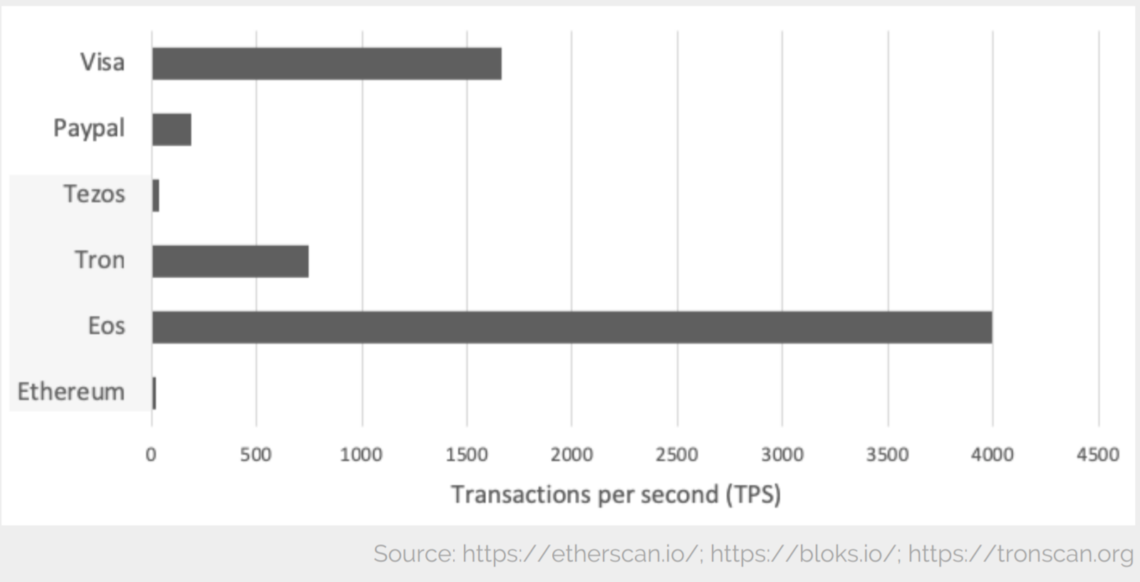Competing protocols are eating away at Ethereum’s market dominance. TRON (TRX), EOS (EOS), and Tezos (XTZ) have all been gaining traction since launching their respective mainnets in 2018.
Bitassist Research & Advisory has conducted an in-depth comparison of four of the leading protocols: Ethereum (ETH), EOS (EOS), TRON (TRX), and Tezos (XTZ). In collaboration with Omenics, “The Battle of the Protocols” investigates the four leading protocols in the cryptocurrency space.
Ethereum is naturally the largest, but its competitors — EOS, TRON, and Tezos — have been gaining in popularity since launching their respective mainnets in 2018.
SponsoredHere are some of the metrics analyzed in Bitassist’s findings.
Ethereum is Slow, EOS is Fast
One of the main metrics analyzed is transactions-per-second (TPS), the rate at which new data can be added and confirmed on the network.
Bitassist considers this to be fundamental to adoption and, moreover, is the most intuitive way to judge the relative strength of each of these protocols. It is also notably the one metric where Ethereum lags the most behind its competitors:
- EOS leads all protocols with around 4000 TPS.
- Visa currently coasts around 1600 TPS.
- Tron features approximately 750 TPS.
- Etherum is last, with a marginal 20 TPS.
Ethereum: The Most Decentralized Protocol
According to Bitassist, a decentralized network is one which prevents a single entity from having decision-making influence. When the four protocols are compared, Ethereum still comes out as being the most decentralized:
- Ethereum is open-source and owned by its Foundation. Bitassist claims reverse transactions are not possible, but it is also susceptible to a 51-percent attack.
- Tezos is the second-most decentralized out of these protocols. Unlike Ethereum, it cannot suffer from a 51-percent attack. Instead, 80 percent of all staked coins are needed to reach consensus.
- EOS and TRON are both described as being ‘semi-decentralized.’ This is because it only requires 21 EOS block producers to make decisions on the platform, with TRON requiring 27. Additionally, transactions can be reversed on both platforms.
Because EOS and TRON are only quasi-decentralized, this partly explains why their TPS counts are much higher than Ethereum’s.
Ethereum: The Most Distributed
Node count is another metric of a healthy protocol. Whereas decentralization refers to governance, node count refers to how well the protocol is dispersed. This is incredibly important when it comes to censorship-resistance, as Bitassist notes.
Ethereum currently boasts the largest number of active nodes, with over 5,000 online as of May 21, 2019. However, the number of nodes have plummeted since summer 2018, when there were some 16,000 of them.
Still, competing protocols are far behind. TRON is second-highest with 1,289 nodes. Tezos and EOS pale in comparison with only 78 and 72 block producers, respectively.
Ethereum’s Scaling Problems
On-chain activity allows us to draw conclusions on the relative value of a protocol. However, on-chain activity can be measured with various different metrics from daily active users to median transaction value. Bitwise documents all of these metrics in its report:
Sponsored Sponsored- Ethereum leads in terms of Daily Active Users (DAU), peaking at around 600k around February 2018. Since then, it has dropped to 270k and has been losing ground to competitors.
- EOS and TRON lead Ethereum in total transaction count. Ethereum, for example, hit 100 percent of its transactional capacity in January 2018 with 1.1M transactions. EOS reached 7M transactions per day in August 2017 — which was only two percent of its total capacity.
The key takeaway is that Ethereum is severely limited by its failure to scale and its competitors have been eating into its on-chain activity since February of last year.
Other Metrics
Bitassist’s report also documents other metrics such as dApp usage, community sentiment and buzz, and how each protocol has performed in the market since Q3 2017.
Overall, the report is an in-depth investigation into four of the leading protocols without any absolutist statements on the value of each protocol’s native currency. It is clear, however, that Ethereum has been steadily losing ground to TRON, EOS, and Tezos.
Do you have any thoughts on Ethereum, EOS, TRON, and Tezos? Let us know your opinions in the comments down below.






